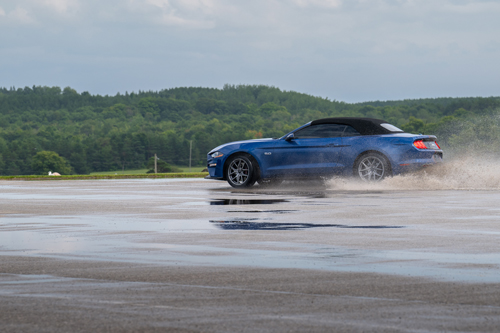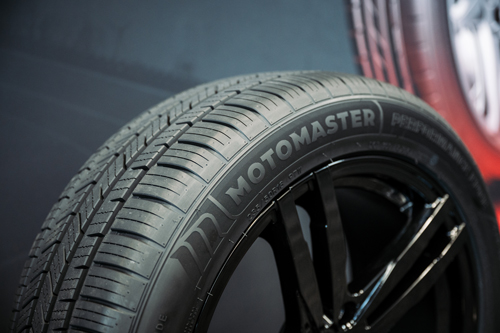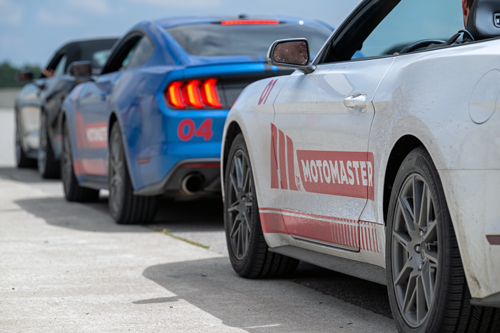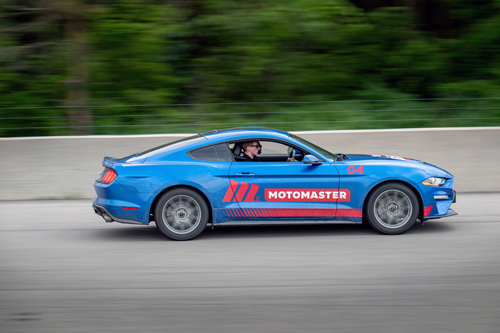There are a couple ways to test tires. The fun way and the serious way. Canadian Tire recently invited a group of journalists to test its latest MotoMaster tire the entertaining way – at the track.

The company bought its new MotoMaster Performance Edge all-season, ultra-high performance (UHP) tire to the track for a demonstration. Mounted on a fleet of Ford Mustangs, the tires were put through their paces by a group of automotive journalists, aided by some true professionals. This was true seat-of-the pants testing, where feeling is everything.
With my behind seated to the right of James Hinchcliffe, I was afforded a truly thrilling ride on the new rubber. Hinch piloted the Mustang around a precision driving course custom designed to show off acceleration, and straight-line braking, high-speed cornering, direction changes and emergency lane changes. The retired IndyCar race driver, and now commentator for Formula 1 and IndyCar – as well as a MotoMaster pitchman – held nothing back as he wove the heavy car through the course. It was a master class in skilled driving.

Now it was my turn to run the track. My foot flat to the floor, the Mustang surged up to 94 km/h before I put all my effort into the brake pedal. The car stopped without engaging the ABS and in a perfectly straight line. That felt good.
Next, through the decreasing radius right hander, feathering the throttle to maintain cornering, the Mustang felt light and controllable on the Performance Edge rubber. Into a slalom run a little too fast, the sportscar still held onto the pavement and rewarded the extra speed. Finally, a last-second emergency lane change and stop allowed the tires to show off their lateral stability and grip under pressure.
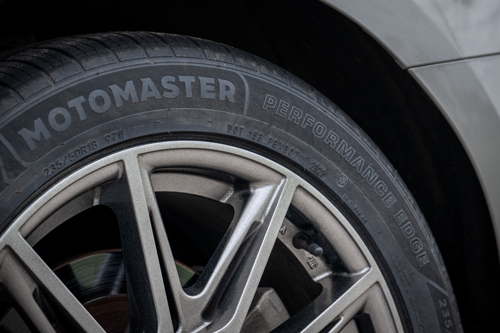
Driver after driver torture-tested the Performance Edge through the course, and in spite of their best efforts, the tires held on beautifully, barely putting up a squeal, and never letting the cars spin, not even once. They definitely created a good first impression.
But testing tires properly is a science. Hi-tech sensors, data collection, rigorous control of conditions, and professional drivers are required to ensure that the tires being scrutinized are all measured fairly and against the same benchmarks.
Canadian Tire has recently begun a program to test the tires it sells and to provide comparative data to its customers so they can make informed decisions about the rubber they put on the road. The retailer’s Road Rated program is run by Andrew Hannaford, who says it’s designed to give consumers data that will help them make an informed choice about their tires. “They can feel confident that the expectation is going to match the performance of the tire,” he says.

Hannaford has been at the helm of the MotoMaster testing program since it began about four years ago. It is part of Canadian Tire’s comprehensive overhaul of the brand, designed to bring it more in tune with what today’s consumers are looking for.
He says it’s been a big investment for the retailer to commit to the rigorous program. It involves renting a test track, hiring drivers and equipment, as well as engaging a third-party independent audit firm that rides along for every test to ensure conformity and that conditions are strictly controlled.
Testing each tire takes about a week of intensive scrutiny, Hannaford said. A reference tire is used to benchmark the testing throughout each test day, as conditions like temperature and humidity can change. As well, “the same person has to be in every car. You can’t switch people, because the weight is different. They’re very concerned about making sure that the conditions are as identical as they can possibly make them,” he explained.
The tires are tested against a number of measures that are grouped into the categories wet, dry, comfort and economy. The new Performance Edge, which is made for MotoMaster by Sailun Tire, was tested in October 2022 against seven competitors, from major producers such as Continental and Michelin.
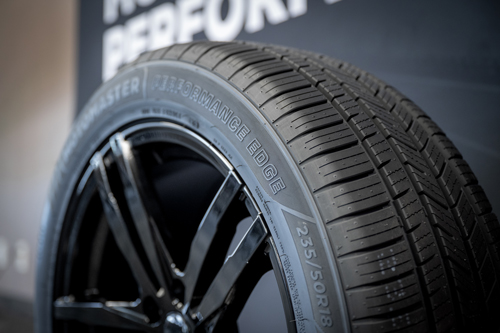
Details about the tire’s compound and construction were scanty at the event, with Canadian Tire simply saying it has an advanced HUP rubber compound with larger shoulder blocks for better handling, braking an cornering.
While the comparative test results are not yet available, MotoMaster reported that its tire had the best overall performance in the wet, and was within two percentage points of the top performers in the dry, comfort and fuel economy categories. And this is for a tire that will be noticeably less expensive than the name brands, with a 16-inch model expected to retail for about $149 when it is launched in March 2024.
One thing the MotoMaster test program has in common with the tire introduction day at the track is subjective rating. Hannaford explained that alongside the scientifically measured tests, professional drivers also provide their feedback on how the tires feel under different driving conditions. “It’s important, because when you get in the car your impression is based on feel,” he noted.
Our afternoon sessions on the development track at Canadian Tire Motorsport Park were designed to give us that experience. As we ripped around the track doing hot laps and ride-alongs with James Hinchliffe and other pro instructors, it was satisfying to know that in a small way we were contributing to the body of knowledge about the new Performance Edge all seasons.
It may be a seat-of-the-pants assessment of the tire’s grip and stability, but it’s good to know that this kind of fun is actually a legitimate part of the process that brings a new tire to market.





